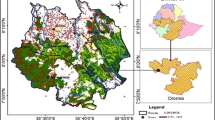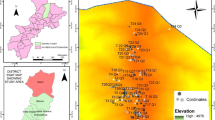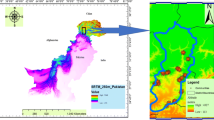Abstract
An understory vegetation survey of the Pinus wallichiana-dominated temperate forests of Swat District was carried out to inspect the structure, composition and ecological associations of the forest vegetation. A quadrat method of sampling was used to record the floristic and phytosociological data necessary for the analysis using 300 quadrats of 10 × 10 m each. Some vegetation parameters viz. frequency and density for trees (overstory vegetation) as well as for the understory vegetation were recorded. The results revealed that in total, 92 species belonging to 77 different genera and 45 families existed in the area. The largest families were Asteraceae, Rosaceae and Lamiaceae with 12, ten and nine species, respectively. Ward’s agglomerative cluster analysis for tree species resulted in three floristically and ecologically distinct community types along different topographic and soil variables. Importance value indices (IVI) were also calculated for understory vegetation and were subjected to ordination techniques, i.e. canonical correspondence analysis (CCA) and detrended correspondence analysis (DCA). DCA bi-plots for stands show that most of the stands were scattered around the centre of the DCA bi-plot, identified by two slightly scattered clusters. DCA for species bi-plot clearly identified three clusters of species revealing three types of understory communities in the study area. Results of the CCA were somewhat different from the DCA showing the impact of environmental variables on the understory species. CCA results reveal that three environmental variables, i.e. altitude, slope and P (mg/kg), have a strong influence on distribution of stands and species. Impact of tree species on the understory vegetation was also tested by CCA which showed that four tree species, i.e. P. wallichiana A.B. Jackson, Juglans regia Linn., Quercus dilatata Lindl. ex Royle and Cedrus deodara (Roxb. ex Lamb.) G. Don, have strong influences on associated understory vegetation. It is therefore concluded that Swat District has various microclimatic zones with suitable environmental variables to support distinct flora.







Similar content being viewed by others
References
Aikens MI, Ellum D, McKenna JJ, Kelty MJ, Ashton MS (2007) The effects of disturbance intensity on temporal and spatial patterns of herb colonization in a southern New England mixed-oak forest. For Ecol Manag 252(1–3):144–158
Ali K (2011) The conservation issues of medicinal plants of the Swat valley, with special reference to the tree flora. PhD dissertation: School of Biological Sciences University of Reading UK. pp 1–468
Ali SI, Qaiser M (eds) (1995-2012) Flora of Pakistan. Fakhri printing Press, Karachi
Ameztegui A, Coll L, Benavides R, Valladares F, Paquette A (2012) Understory light predictions in mixed conifer mountain forests: role of aspect-induced variation in crown geometry and openness. For Ecol Manag 276:52–61
Barbier S, Gosselin F, Balandier P (2008) Influence of tree species on understory vegetation diversity and mechanisms involved—a critical review for temperate and boreal forests. For Ecol Manag 254(1):1–15
Baruch Z (2005) Vegetation–environment relationships and classification of the seasonal savannas in Venezuela. Flora 200:49–64
Behera MD, Kushwaha SPS, Roy PS, Srivastava S, Singh TP, Dubey RC (2002) Comparing structure and composition of coniferous forests in Subansiri district, Arunachal Pradesh. Curr Sci 82(1):70–76
Berger AL, Puettmann KJ (2000) Overstory composition and stand structure influence herbaceous plant diversity in the mixed aspen forest of northern Minnesota. Am Midl Nat 143:111–125
Bharali S, Paul A, Khan ML, Singha LB (2011) Species diversity and community structure of a temperate mixed Rhododendron forest along an altitudinal gradient in West Siang District of Arunachal Pradesh, India. Nature and Science 9(12)
Bingham FT (1949) Soil tests for phosphate. Calif Agric 3:11–14
Bratton S (1976) Resource division in an understory herb community: responses to temporal and microtopographic gradients. Am Nat 110:679–693
Bremner MM (1965) Total nitrogen. In: Black CA (ed) Method of soil analysis, part II. Madison, American Society of Agriculture, pp 1149–1178
Chaping FS III, Callaghan TV, Bergeron Y, Fukuda M, Johnstone JF, Juday GP, Zimov SA (2004) Global change and the boreal forest: thresholds, shifting states or gradual change? Ambio 33:361–365
Chavez V, Macdonald SE (2010) The influence of canopy patch mosaics on understory plant community composition in boreal mixed wood forest. For Ecol Manag 259(6):1067–1075
Cox GW (1967) Laboratory manual of general ecology. W.M.C. Brown. Co. Publ. Iowa, U.S.A. 165 pp
Crozier CR, Boerner REJ (1984) Correlations of understory herb distribution patterns with microhabitats under different tree species in a mixed mesophytic forest. Oecologia 62:337–343
Dahlgren RA, Driscoll CT (1994) The effects of whole-tree clear-cutting on soil processes at the Hubbard Brook Experimental Forest, New Hampshire, USA. Plant Soil 158:239–262
Dauber J, Hirsch M, Simmering D, Waldhardt R, Otte A, Wolters V (2003) Landscape structure as an indicator of biodiversity: matrix effects on species richness. Agric Ecosyst Environ 98(1–3):321–329
Ellsworth JW, Harrington RA, Fownes JH (2004) Seedling emergence, growth, and allocation of oriental bittersweet: effects of seed input, seed bank, and forest floor litter. For Ecol Manag 190(2–3):255–264
Ghimire BK, Lekhak HD, Chaudhary RP, Vetaas OR (2008) Vegetation analysis along an altitudinal gradient of Juniperus indica forest in southern Manang Valley, Nepal. International Journal of Ecology & Development 9:20–29
Hart S, Chen H (2006) Understory vegetation dynamics of North American boreal forests. Crit Rev Plant Sci 25(4):381–397
Hinsinger P, Elsass F, Jaillard B, Robert M (1993) Root-induced irreversible transformation of a trioctahedral mica in the rhizosphere of rape. J Soil Sci 44:535–545
Hornung M, Reynolds B, Stevens PA, Hugue S (1990) Water quality changes from input to stream. J Soil Sci 41:223–240
Huo H, Feng Q, Su Y (2014) The influences of canopy species and topographic variables on understory species diversity and composition in coniferous forests. The Scientific World Journal Volume 2014, Article ID 252489, 8 pages doi: 10.1155/2014/252489
Hussain F (1989) Filed and laboratory manual of plant ecology. N.A.H.E., University Grants Commission, Islamabad. 422 pp.
Ilahi I, Suleman M (2013) Species composition and relative abundance of mosquitoes in Swat, Pakistan. International Journal of Innovation and Applied Studies 2(4):454–463
Jabeen T, Ahmed SS (2009) Multivariate analysis of environmental and vegetation data of Ayubia National Park, Rawalpindi. Soil and Environment 28:106–112
Jackson ML (1958) Soil chemical analysis. Englewood cliff, NJ: Prentice Hall press, pp. 87–110
Jain SK, Rao RR (1977) A hand book of field and herbarium methods. Today and Tomorrow Publication, New Delhi
Jiang Y, Kang MY, Zhu Y, Xu GC (2007) Plant biodiversity patterns on Helan Mountain, China. Acta Oecol 32:125–133
Jongman RHG, ter Braak CFJ, Tongeren OFR (1995) Data analysis in community and landscape ecology, Second edn. Cambridge University Press, Cambridge, UK
Knapp R (1958) The influence of different tree species on the plants growing beneath them (in German). Ber Dtsch Bot Ges 71:411–421
Koorem K, Moora M (2010) Positive association between understory species richness and a dominant shrub species (Corylus avellana) in a boreonemoral spruce forest. For Ecol Manag 260(8):1407–1413
Lefrancois M, Beaudet M, Messier C (2008) Crown openness as influenced by tree and site characteristics for yellow birch, sugar maple, and eastern hemlock. Can J For Res 38(3):488–497
Lemée G (1975) Recherches sur les écosystèmes des réserves biologiques de la forêt de Fontainebleau. III. Influence du peuplement graminéen sur les caractères et l’activité biologique du mull acide. Rev Écol Biol Sol 12:157–167
Leyval C, Berthelin J (1983) Effects rhizosphèriques de plantes indicatrices de grands types de pédogènèse sur quelques groupes bactériens modifiant l’état des minéraux. Rev Écol Biol Sol 20:191–206
Macdonald SE, Fenniak TE (2007) Understory plant communities of boreal mixed wood forests in western Canada: natural patterns and response to variable-retention harvesting. For Ecol Manag 242(1):34–48
McCune B, Mefford M J (2005) Multivariate analysis of ecological data. PC. ORD Version 5.10 MjM Software, Gleneden Beach, Oregon, U.S.A.
McKenzieand D, Halpern CB (1999) Modeling the distributions of shrub species in Pacific northwest forests. For Ecol Manag 114(2–3):293–307
Molder A, Bernhardt-Romermann M, Schmidt W (2008) Herb layer diversity in deciduous forests: raised by tree richness or beaten by beech? For Ecol Manag 256(3):272–281
Naqinezhad AR, Hamzehee B, Attar F (2008) Vegetation-environment relationships in the alderwoods communities of Caspian lowlands, N. Iran (toward an ecological classification). Flora 203:567–577
Nasir E, Ali SI (eds) (1971-1995) Flora of West Pakistan. Fakhri Press, Karachi
North M, Oakley B, Fiegener R, Gray A, Barbour M (2005) Influence of light and soil moisture on Sierran mixed-conifer understory communities. Plant Ecol 177(1):13–24
Ovington JD (1955) Studies of the development of woodland conditions under different trees. III. The ground flora. Ecology 43:1–21
Palik B, Engstrom RT (1999) Species composition. In: Hunter MJ (ed) Maintaining biodiversity in forest ecosystems. Cambridge University Press, Cambridge, pp 65–94
Palmer MW (1993) Putting things in even better order: the advantages of canonical correspondence analysis. Ecology 74:2215–2230
Paul A (2008) Studies on diversity and regeneration ecology of Rhododendrons in Arunachal Pradesh. Ph.D. thesis, Assam University, Silchar, Assam, India
Perala DA, Alban DH (1982) Biomass, nutrient distribution and litterfall in Populus, Pinus and Picea stands on two different soils in Minnesota. Plant Soil 64:177–192
Qian H, Klinka K, Økland RH, Krestov P, Kayahara GJ (2003) Understory vegetation in boreal Picea mariana and Populus tremuloides stands in British Columbia. J Veg Sci 14(2):173–184
Rees DC, Juday GP (2002) Plant species diversity on logged versus burned sites in central Alaska. For Ecol Manag 155:291–302
Roberts MR, Zhu L (2002) Early response of the herbaceous layer to harvesting in a mixed coniferous-deciduous forest in New Brunswick, Canada. For Ecol Manag 155(1–3):17–31
Switzer GL, Nelson LE, Smith WH (1968) The mineral cycling in forest stands, In: Tenessee Valley Authority (Ed.), Forest fertilization, theory and practice, pp. 1–9.
Thomsen RP, Svenning J, Balslev H (2005) Overstory control of understory species composition in a near-natural temperate broad leaved forest in Denmark. Plant Ecol 181(1):113–126
Warren SL, Monaco TJ, Skroch KB (1987) Effect of vegetation management on soil nutrients and nutrient content of herbaceous vegetation. J Amer Soc Hort Sci 112:962–968
Wedraogo FX, Belgy G, Berthelin J (1993) Seasonal nitrification measurements with different species of forest litter applied to granite-sand-filled lysimeters in the field. Biol Fertil Soils 15:28–34
Whigham DF (2004) Ecology of woodland herbs in temperate deciduous forests. Annu Rev Ecol Evol Syst 35:583–621
Yu M, Sun OJX (2013) Effects of forest patch type and site on herb-layer vegetation in a temperate forest ecosystem. For Ecol Manag 300(1):14–20
Author information
Authors and Affiliations
Corresponding author
Additional information
Communicated by: Sven Thatje
Rights and permissions
About this article
Cite this article
Rahman, I.U., Khan, N. & Ali, K. Classification and ordination of understory vegetation using multivariate techniques in the Pinus wallichiana forests of Swat Valley, northern Pakistan. Sci Nat 104, 24 (2017). https://doi.org/10.1007/s00114-017-1431-2
Received:
Revised:
Accepted:
Published:
DOI: https://doi.org/10.1007/s00114-017-1431-2




